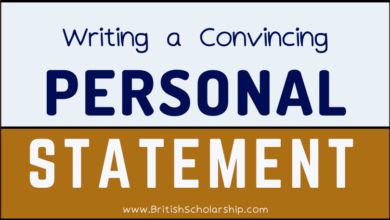Writing a Convincing Research Proposal for Scholarship Application

Scholarship applications are a crucial part of the high school experience. They provide students with the opportunity to gain valuable knowledge and skills to help them pursue their dreams after graduation. Scholarship recipients are chosen by committees or panels that review applications from all over the country. These panels can be very thorough in their selections, so it’s important to have a convincing research proposal ready for them when they ask for one!
This guide will tell you everything you need to know about writing a research proposal for scholarship applications so that you can begin preparing your application today.
Make a Plan for What you will Write.
A research proposal is a document that outlines the purpose of your research study project, how it will be conducted, material/funding requirements, discuss the novelty of the research, and a roadmap for completing it with the possible outcome. You’ll need to provide information about:
- What you’re studying
- Who will participate (including names and contact information)
- When you plan on starting your project (including start date)
- You can use templates like these in Microsoft Word or Google Docs.
What’s the Ideal Length for a Research Proposal?
It should be between 8,00 and 3,500 words (2 to 7 pages).
Writing a Successful Research Proposal for Scholarship Application
When writing a research proposal, there are many ways to approach the task. However, not all approaches are equally effective. In this blog post, we will discuss how you can write a successful research proposal by considering the key elements:
Here’s a step-by-step guide to submitting your research proposal:
- Title
This is the first thing a reader will see. It should be concise but also clear and informative. It needs to convey who you are and what you’re writing about, so try using pronouns like “I” or “we” in your title instead of just saying “Thesis Proposal.”
- Abstract
The abstract is a summary of your research proposal and should be written in the same language as the rest of your proposal. For example, if you’re writing an abstract in English and then translating it into Spanish or French when submitting your scholarship application to one of these institutions (or even another), make sure that you don’t use slang words or phrases from those countries!
The length of an abstract varies depending on how long it takes for someone to read through all of them. Give yourself enough time without having too many long words in there—this can cause problems with formatting and layout later on down the line when trying to compile everything into one document before submitting it.
- Introduction
The introduction is the first section of your research proposal. It should be a brief summary of your study’s problem statement and purpose, followed by an explanation of what you plan to do (or not do) in this research project.
The following sections should also be included:
Purpose/novelty of proposed research: State why you are conducting this study and how it will advance knowledge or solve a problem for your field.
Research questions, objectives, and hypotheses (i.e., what we hope to learn). If applicable, include any pre-existing hypotheses that have been tested previously as part of another project or within another discipline; these may also serve as starting points for further research if necessary!
- Problem Statement and Justifications
The problem statement is the problem you are trying to solve. Your scholarship application could be something like “How can we increase the number of women in science?” or “How can we improve the diversity of our faculty?” The justifications are why you are writing this research proposal and how it will help solve these problems.
- Literature Review
A literature review is a summary of the existing knowledge on the subject as the basis of your proposed research. It’s important to include it because it provides context for your research questions, objectives, and hypotheses. A literature review summarizes what has been done before in this area, identifies gaps in our understanding, and suggests new directions for future work.
- Research Questions, Objectives, and Hypotheses
Research questions are statements you want to answer using quantitative or qualitative research (or both). For example: “Is there evidence supporting an increase in teenage college admission acceptance rates between 2020 and 2022?” This question asks you to look at past trends in data to identify possible causes for those trends so we can better understand why they occurred.
- Scope of the Study and Theoretical Framework
The scope of the study and theoretical framework for your research proposal should be explained in clear and concise terms. This is an important part of the process because it will help you determine the type of research most appropriate for this scholarship application.
Theoretical framework refers to all of the concepts, theories, assumptions, and methods used by researchers when conducting their research projects. Students must understand how these ideas influence their chosen topic(s) before choosing a specific project based on them; otherwise, they may be left wondering why they chose something different than what they had originally planned on doing!
- Significance of the Study; Research Methodology
This section is where you explain why your project is important and how it will add to the existing body of knowledge. You should include:
Why do you think this research is necessary?
What have other studies been done on this topic or similar over time? How do they compare with yours regarding methodology, findings, and conclusions/implications for future research (if any)?
In what ways does your study differ from previous efforts? What makes your approach stand out as unique among all other projects currently underway or completed within a particular field/discipline such as medicine or biology etc., or even in comparison with those undertaken at other institutions worldwide.
- Possible Limitations of the Study
The study should be conducted over a period of no more than one year, and it must be carried out in the country where the research is being conducted. If you want to apply for a scholarship, your study must take place for at least half of that time period.
You must outline this information in your proposal so that there will not be any confusion or miscommunication between yourself and potential sponsors or mentors who are reviewing your application materials or conducting interviews with you as part of their selection process. You can also include some basic details about how long each session will last (for instance: two days per week), which may help other people understand what activities they could expect from you during such sessions when they review those sections later on during their reviews.
- Mention the Required Funds
You should mention the overall research budget. You must break down the research into manageable portions and specify how much each will cost. Make sure to include every cost. You hardly ever get more money after you’ve been given a certain amount.
It takes a lot of time and effort, but it is worth it when you get your scholarship. If you follow these simple steps, you can write a research proposal that will stand out from the rest.



